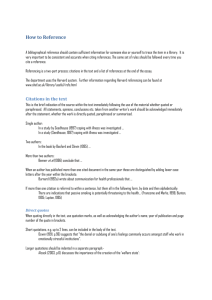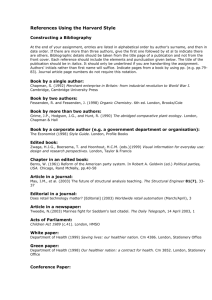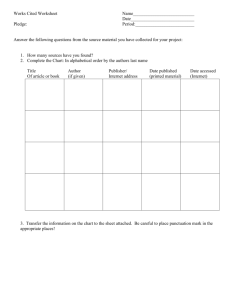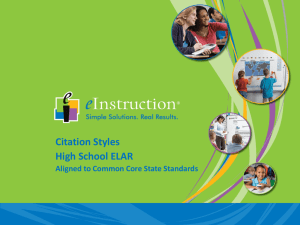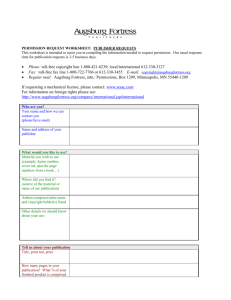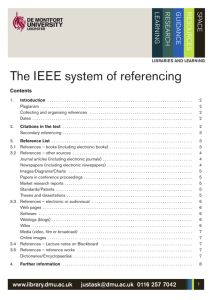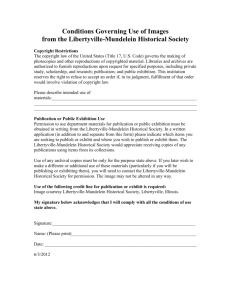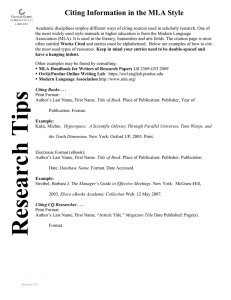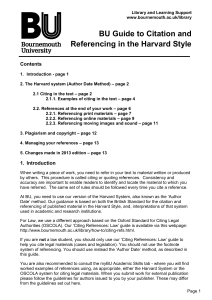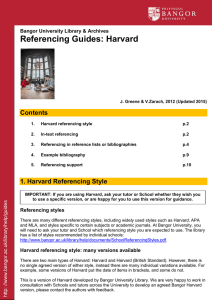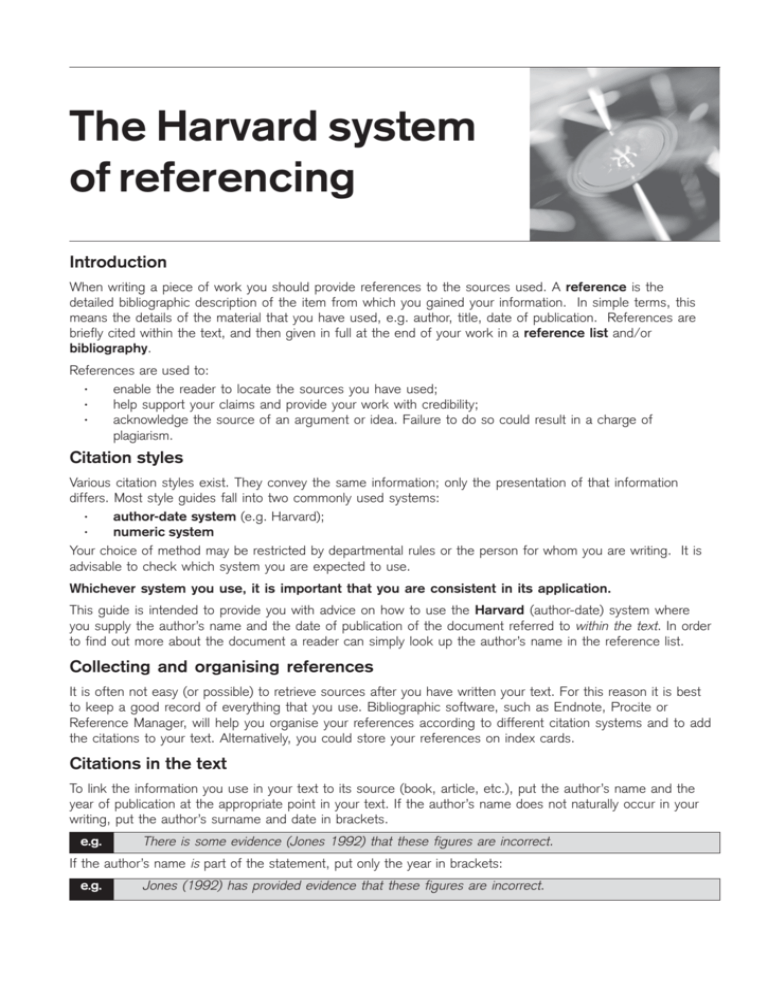
The Harvard system
of referencing
Introduction
When writing a piece of work you should provide references to the sources used. A reference is the
detailed bibliographic description of the item from which you gained your information. In simple terms, this
means the details of the material that you have used, e.g. author, title, date of publication. References are
briefly cited within the text, and then given in full at the end of your work in a reference list and/or
bibliography.
References are used to:
·
enable the reader to locate the sources you have used;
·
help support your claims and provide your work with credibility;
·
acknowledge the source of an argument or idea. Failure to do so could result in a charge of
plagiarism.
Citation styles
Various citation styles exist. They convey the same information; only the presentation of that information
differs. Most style guides fall into two commonly used systems:
·
author-date system (e.g. Harvard);
·
numeric system
Your choice of method may be restricted by departmental rules or the person for whom you are writing. It is
advisable to check which system you are expected to use.
Whichever system you use, it is important that you are consistent in its application.
This guide is intended to provide you with advice on how to use the Harvard (author-date) system where
you supply the author’s name and the date of publication of the document referred to within the text. In order
to find out more about the document a reader can simply look up the author’s name in the reference list.
Collecting and organising references
It is often not easy (or possible) to retrieve sources after you have written your text. For this reason it is best
to keep a good record of everything that you use. Bibliographic software, such as Endnote, Procite or
Reference Manager, will help you organise your references according to different citation systems and to add
the citations to your text. Alternatively, you could store your references on index cards.
Citations in the text
To link the information you use in your text to its source (book, article, etc.), put the author’s name and the
year of publication at the appropriate point in your text. If the author’s name does not naturally occur in your
writing, put the author’s surname and date in brackets.
e.g.
There is some evidence (Jones 1992) that these figures are incorrect.
If the author’s name is part of the statement, put only the year in brackets:
e.g.
Jones (1992) has provided evidence that these figures are incorrect.
If there are two authors, give both:
e.g.
It is claimed that government in the information age will “work better and cost less” (Bellamy and
Taylor 1998, p. 41).
Note: if you are giving a direct quotation then you need to include the page number.
If there are more than two authors, cite only the first followed by ‘et al.’ (and others):
e.g.
…adoptive parents were coping better with the physical demands of parenthood and found
family life more enjoyable (Levy et al. 1991).
If an author has published more documents in the same year, distinguish between them by adding
lower-case letters:
e.g.
In recent studies by Smith (1999a, 1999b, 1999c)….
References
Full references of sources used are given at the end of your work. This list of references or bibliography is
arranged alphabetically. Whenever possible, elements of a bibliographical reference should be taken from the
title page of the publication. Each reference should give the elements and punctuation as found below. In
these examples, the source (e.g. title) has been italicised; you can also emphasise the source by underlining
or typing in bold. It does not usually matter which you use, so long as you are consistent throughout your
reference list.
Books
AUTHOR(S) (Year) Title, Edition. Place of publication, Publisher.
e.g.
GOLOMBOK, S. (2000) Parenting: what really counts? London, Routledge.
Books with two or three authors
e.g.
LI, X. and CRANE, N.B. (1993) Electronic style: a guide to citing electronic information. London,
Meckler.
Books with more than three authors
Give the name of the first author, followed by ‘et al.’ (and others).
e.g.
LEVITT, R. et al. (1999) The reorganised National Health Service. 6th ed. Cheltenham, Stanley
Thornes.
Chapters in books
AUTHOR(S) (Year) Title of chapter. In: AUTHOR(S)/EDITOR(S) Book title. Place of publication, Publisher,
Pages (p. or pp.).
e.g.
TUCKMAN, A. (1999) Labour, skills and training. In: LEVITT, R. et al. The reorganised National
Health Service. 6th ed. Cheltenham, Stanley Thornes, pp. 135-155.
Electronic information
Electronic references should contain the following elements:
AUTHOR(S) (Year) Title of document [Type of resource, e.g. CD-ROM, e-mail, WWW] Organisation
responsible (optional). Available from: URL address. [Date accessed].
e.g .
UNIVERSITY OF SHEFFIELD LIBRARY (2001) Citing electronic sources of information [WWW]
Sheffield, University of Sheffield. Available from: http://www.shef.ac.uk/library/libdocs/hsldvc2.html [Accessed 6/8/03].
If you are referencing an item, such as a journal article, use the normal format for that item then add the type
of resource, URL and accessed details, as for electronic information.
e.g.
DREXHAGE, J. (2004) Still up in the air. Carbon finance, January, pp 16-17 [WWW] Available
from: http://www.iisd.org/pdf/2004/climate_still_up_air.pdf [Accessed 12/2/04].
Exhibition catalogues
ARTIST (Year) Title of exhibition [Exhibition catalogue] Place of publication, Publisher.
e.g.
HARRIS, W. (1983) William Harris as designer [Catalogue of an exhibition held at the Whitworth
Art Gallery, 3 May – 4 June 1983] London, Arts Council.
Journal articles
AUTHOR(S) (Year) Title of article. Title of journal, Vol. no. (Part no.), Pages (p. or pp.).
e.g.
LU, H., and MIETHE, T.D. (2002) Legal representation and criminal processing in China.
British journal of criminology, 42 (2), pp. 267-280.
Media (video, film, or broadcast)
Title (Year) Type of media. ORIGINATOR (e.g. director). Place of production, Producer.
e.g.
Rebel without a cause. (1983) Film. Directed by Nicholas RAY. USA, Warner Bros.
A television broadcast should also include the date and time of broadcast, where possible.
e.g.
Dyslexic children. (1999) TV. Channel 4, July 29, 1900 hrs.
Newspaper articles
AUTHOR(S) (Year) Article title. Newspaper title, Day, Month (abbreviated), Page(s).
e.g.
BROWN, P. (2002) New foot and mouth outbreak suspected. Guardian, 27 Feb., p. 1.
Online images
Description or title of image (Year) [Online image] ORIGINATOR (if relevant). Available from: URL address.
[Date accessed].
e.g.
Hubble space telescope release in the space shuttle’s payload bay (1994) [Online image]
Available from: http://explorer.arc.nasa.gov/pub/SPACE/GIF/s31-04-015.gif [Accessed 1/10/
96].
Papers in conference proceedings
AUTHOR(S) (Year) Title. In: EDITOR(S) Title of conference proceedings. Place and date of conference
(unless included in title). Place of publication, Publisher, Page(s).
e.g.
GIBSON, E.J. (1977) The performance concept in building. In: Proceedings of the 7th CIB
Triennial Congress. Edinburgh, September 1977. London, Construction Research
International, pp. 129-136.
Publications from a corporate body (e.g. Government publications)
NAME OF ISSUING BODY (Year) Title. Place of publication, Publisher, Report no. (where relevant), Page(s).
e.g.
DEPARTMENT OF THE ENVIRONMENT, Development Commission (1980) 38th Report. 1st
April 1979 to 31st March 1980. London, HMSO, 1979-80 HC. 798, pp. 70-81.
Theses and dissertations
AUTHOR (Year) Title. Designation (Level, e.g. MSc., PhD.), Institution.
e.g.
MARSHALL, J. (2002) The Manuscript tradition of Brunetto Latini’s “Tresor”. Unpublished thesis
(PhD), University of London.
Further Information
Further help and guidance on citation and referencing can be obtained from the following online sources.
Remember, it is always advisable to consult the person for whom you are writing, whether it is a tutor or an
editor, as to which style of referencing they want you to use.
HARNACK, A., and KLEPPINGER, E. (2003) Online! A reference guide to using internet sources [WWW].
Bedford, St Martin’s. Available from: http://www.bedfordstmartins.com/online/index.html [Accessed 1/3/04].
HOLLAND, M. (2003) Citing references – the Harvard system [WWW]. Bournemouth, Bournemouth
University. Available from: http://www.bournemouth.ac.uk/library/using/citing_references.html [Accessed 1/
3/04]
UNIVERSITY OF BIRMINGHAM [2002], Preparing & quoting references [WWW]. Birmingham, University of
Birmingham, Information Services. Available from: http://www.is.bham.ac.uk/ppm/publications/skills/
preparing.pdf [Accessed 1/3/04].
UNIVERSITY OF SHEFFIELD LIBRARY (2001) Citing electronic sources of information [WWW] Sheffield,
University of Sheffield. Available from: http://www.shef.ac.uk/library/libdocs/hsl-dvc2.html [Accessed 1/3/04]
thesis (PhD), University of London.
© De Montfort University Library Services 2004
all rights reserved
All libraries
www.library.dmu.ac.uk
04010
design Library print The Printing Centre
Library user guide series
large print
screen (PDF)

